#qianlong dynasty
Text
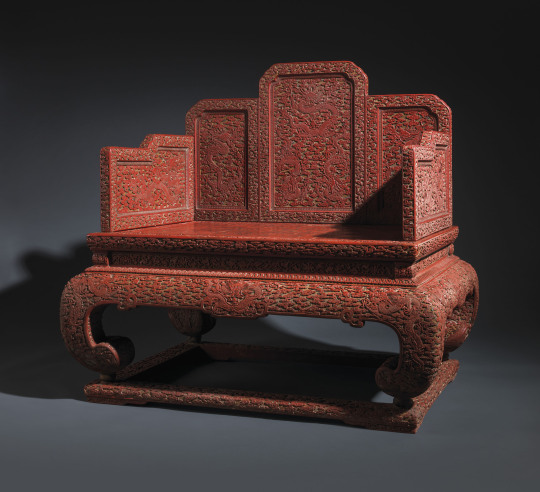




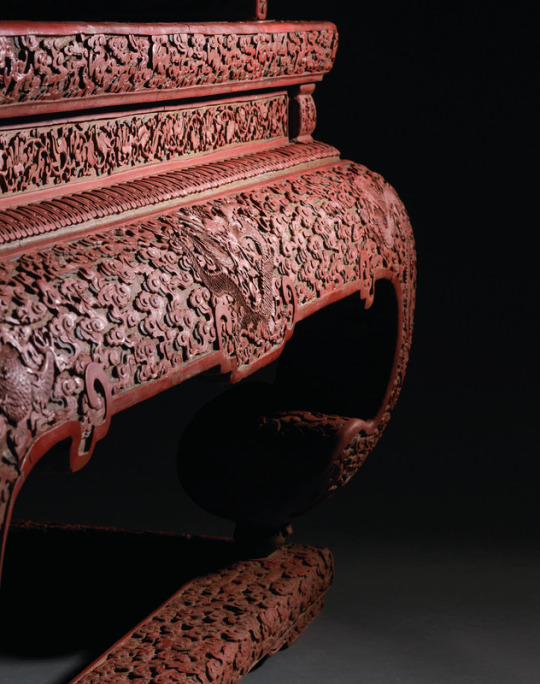

Imperial three-colour carved ‘Nine Dragon’ lacquer throne,
Qianlong period (1736-1795).
The throne is finely carved through the red lacquer to the ochre and dark green lacquer and has a stepped back separated into three vertical panels each containing dragons chasing flaming pearls amidst dense clouds.
The two side railings are similarly carved in high-relief with dragons striding amidst bats in flight and dense scrolling clouds above a rectangular seat decorated with archaistic lotus scroll and a narrow waist with a shaped apron centred with a front-facing dragon.
The back panel is carved with a bat suspending a chime and a double-fish. The whole is raised on thick rounded legs joined by rectangular base stretchers.
43¼ x 45½ x 33¾ in (111.1 x 115.5 x 85.7 cm)
Courtesy: Christie's
#art#history#design#style#sculpture#antiquity#christie's#throne#china#laquered#millwork#dragon#happy year of the dragon!#happy lunar year 2024#happy lunar new year#imperial#qianlong dynasty
86 notes
·
View notes
Text

Snuff Bottle. Chinese origin, made during the Qianlong reign period (1736–1795) of the Qing Dynasty (1644–1911). Medium is pink glass with white and black overlay. Dimensions: h. 7.3 cm x w. 6.0 cm x d. 2.8 cm. From the Princeton University Art Museum, object number: y1936-539.
(Source: artmuseum.princeton.edu)
#bottle#vessels#1700s#18th century#qianlong period#qing dynasty#chinese design#animal motif#horses#glass#pink#white
275 notes
·
View notes
Text
Abridged History of Qing Dynasty Han Women’s Fashion (part 5: Late Qianlong & Jiaqing eras)

(artwork from 1782)
Previous posts:
Late Ming & Shunzhi era
Kangxi era
Late Kangxi & Yongzheng eras
Qianlong era
The last two decades of the Qianlong era, the 1780s and 90s, formed one aesthetic continuity with the reign of Qianlong’s successor Jiaqing (1796-1820). This period was characterized by a turn to extreme formal simplicity and what I believe to be a revival of the tastes of the Ming-Qing transition.
We see sleeves of women’s robes, tight fitting and short to create a practical look in the previous era, become wider and longer. The folded cuff design was retained, though now more difficult to manage as the sleeves became wider. In the last post I discussed how the construction of dajin similar to Manchu men’s fashion became en vogue among Han women and replaced the earlier center front closing robes----this remained the same. We see some of the first instances of binding strips being used around the collar and the dajin, which would become a highly popular and elaborate craft later in the 19th century. Around this time, the binding strips used were usually thin and minimal, commonly of a black color. Plain cloth or bead tip buttons were popularized earlier in the Qianlong era, and metal clasp buttons (zimukou) became increasingly rare. The shape of the standing collar remained the same as that of previous centuries, soft, unstiffened and tall.
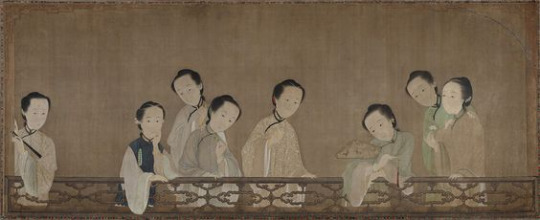
Artwork from 1796 showing a group of courtesans. You can see the black binding on some of their robes. A note about the dating of this artwork: while it’s quite a common reference image for Jiaqing era fashion, I wasn’t able to find an exact date until I read about it in the book Pictures for Pleasure and Use by James Cahill (spectacular book discussing the importance of vernacular and commercial art, highly recommend) and he said the date of creation was signed in the cyclical calendar and corresponds to either 1736 or 1796. He was inclined to 1736 because of “similar face shapes” or something to Yongzheng era artworks, but since he wasn’t a fashion historian he probably wasn’t aware that the fashions depicted here would not have been possible before the 1780s, so I think 1796 is instead the correct date.
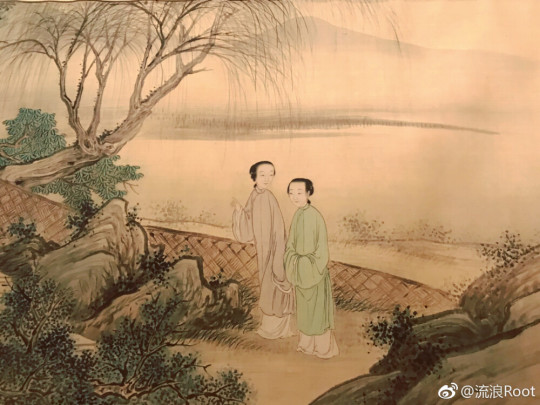
Late Qianlong/early Jiaqing era artwork, showing two austerely (and fashionably) dressed women.
The more radical departure from the previous era, however, was the complete eradication of ornament. Robes and skirts of this era were often entirely plain, with no brocaded patterns or embroidery of any kind. Gone were the roundel patterns, quatrefoil motifs on collar facings and decorative strips around skirts----only solid color blocks remained. Pastel colors like light pink, blue and green were among the most popular for robes besides bright blue and red, whereas skirts were white or black.

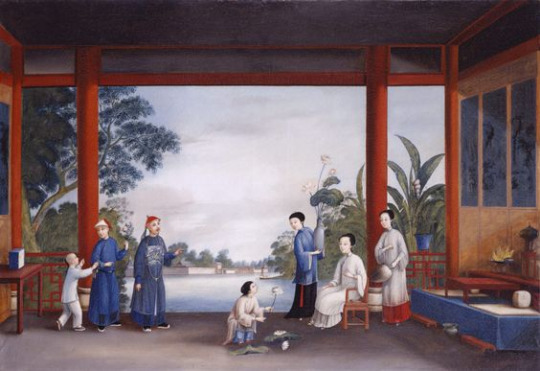
Late Qianlong/early Jiaqing era paintings of the Anglo-Chinese school showing the new style of plain garments.

Artwork from the era showing a woman in a light mustard robe with dusty pink cuffs, white skirt and red sash (sashes were still commonly worn).
The other significant changes happened in hairstyling. The 1780s did away with the iconic tall knots of the earlier Qianlong era, instead moving the mass and volume of hair toward the back. We see the re-emergence of the swallow tail. The front of the hair could be middle parted or completely pulled back. Flowers and other ornaments could be worn on the sides of the hairdo, behind the ears. The general shape of hairstyles stressed horizontality rather than verticality, as was the case before.
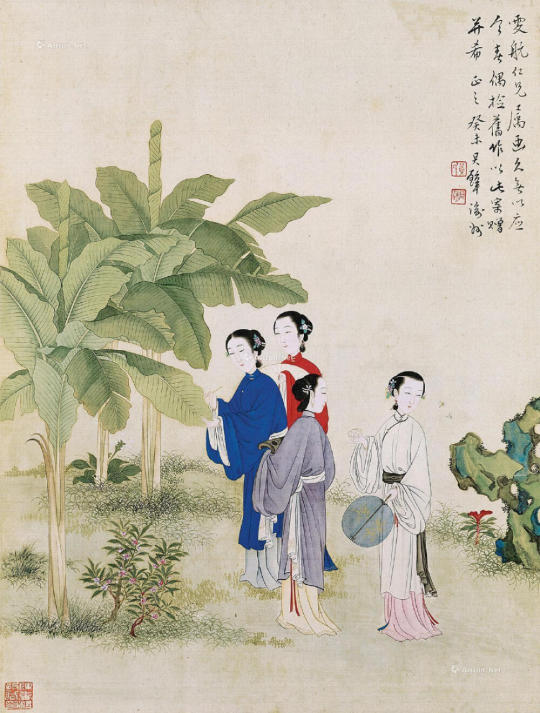
A 1943 copy of a turn of the 19th century original, showing the front and back of hairstyles.

Bust portrait showing the new hairstyle.
A unique hair accessory of the 1780s and 90s was a new iteration of the mo’e, which now had a sharply pointed triangular front and was worn high on the head instead of at the forehead. I think it became less common as the 19th century approached.
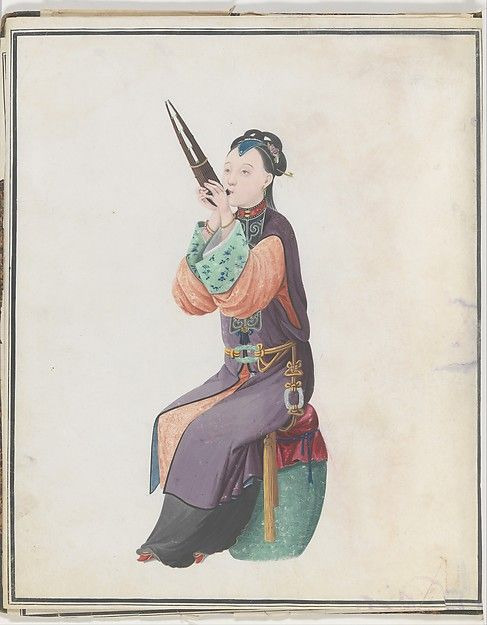
Export artwork showing a woman musician, likely 1770s or 80s as she is still wearing the ornamented, center front closing robes popular in previous decades.
Minimalism was not to last long, however, and soon decorative patterns began to reappear on robes, sleeve cuffs and skirts. Hairstyles began to gain volume and became more puffed, forming a sort of face framing crown. New styles of decorating skirts appeared, with binding going around the qunmen and the edge of each pleat, and embroidery on each individual pleat. The rectangular or circular patterned patch popular prior to the 1780s returned.

Early 19th century export painting at the Brighton Pavilion, maybe 1810s. We can see roundel patterns on the blue robe, embroidery on the cuffs and skirt, and the lady in red wears a pointed mo’e.

Presumably later Jiaqing era artwork, ca. 1810s, showing a group of women. Floral embroidery is present on the sleeve cuffs, the skirts are decorated.
#abridged history of qing dynasty han women's fashion#18th century#19th century#qianlong era#jiaqing era#qing dynasty#chinese fashion#fashion history#regency era
177 notes
·
View notes
Text
UK kitchen vase turns out to be $1.8 million Qing-dynasty treasure

A royal blue 18th-century Chinese vase decorated with gold and silver, which sat in a U.K. kitchen for several years, just sold at auction for about $1.8 million after historians realized it had once belonged to an emperor.
However, the vase's unclear history — combined with the looting of Chinese palaces in the 19th century — raises ethical concerns, according to an expert who was not involved with the sale.
The vase is large, about 2 feet (0.6 meters) tall, and it is marked with a symbol associated with the Qianlong emperor — the sixth emperor of the Qing dynasty, the country's last imperial dynasty — who ruled China from 1735 to 1795, according to a statement released by the auction company Dreweatts, which sold the vase on May 18. Read more.
438 notes
·
View notes
Text
Emperor Qianlong and his influence on the Qing Dynasty
Qianlong (乾隆皇帝) , personal name “HongLi” was born on September 25 of 1711 in Beijing, China.
He was the fourth and favorite son of Emperor Yongzheng and ascended the throne in 1735 and reigned for more than 60 years.
The Emperor had a strong resilient spirit as he excelled both in military campaigns, allowing China to flourish with the chinese empire reaching its peak years during his 60 year reign, but he was also an enjoyer of arts and literature preserving the spirits of his father and grandfather who where both equally invested in this aspect.
During his lifetime he had about 50 consorts and concubines that served him including 3 empresses, 5 imperial noble consorts, 5 noble consorts, 6 consorts, 6 imperial concubines, 12 noble ladies, 4 female attendants, 5 “choice ladies” and 2 GeGe (格格)
the most famous out of all of them was Ula Na’ra (The Empress Nara of the Nara clan) (i will make another post explaining this and getting more in depth with her personal story)
now there are a lot of things i could say about Qianlong but it will be divided into many many parts as the story and dramas are never-ending (why do u think there are so many series based on him ?hahah)
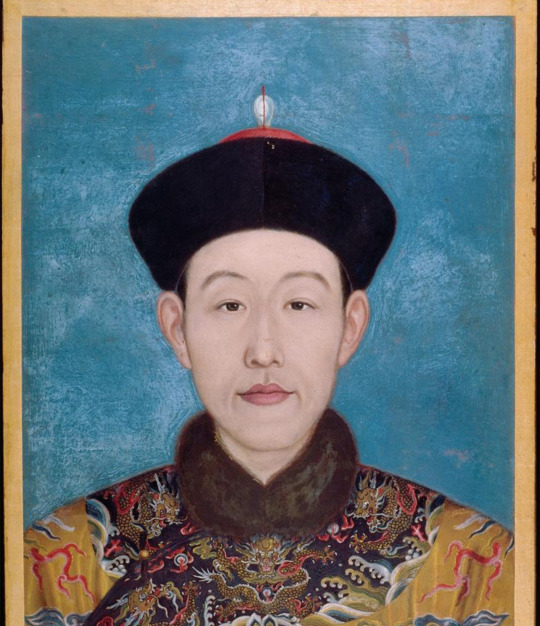

Qianlong

Empress Nara
if u read my previous post you’ll know why she’s wearing three earrings in each ear 😏😙
*fun fact Qianlong is believed to have destroyed all of her portraits so we don’t actually know if this is actually her*
(Chinese equivalent of Anne Boleyn ??)
#china#chinese history#history#qing dynasty#education#language#qianlong#qing#ancient china#18th century
3 notes
·
View notes
Photo


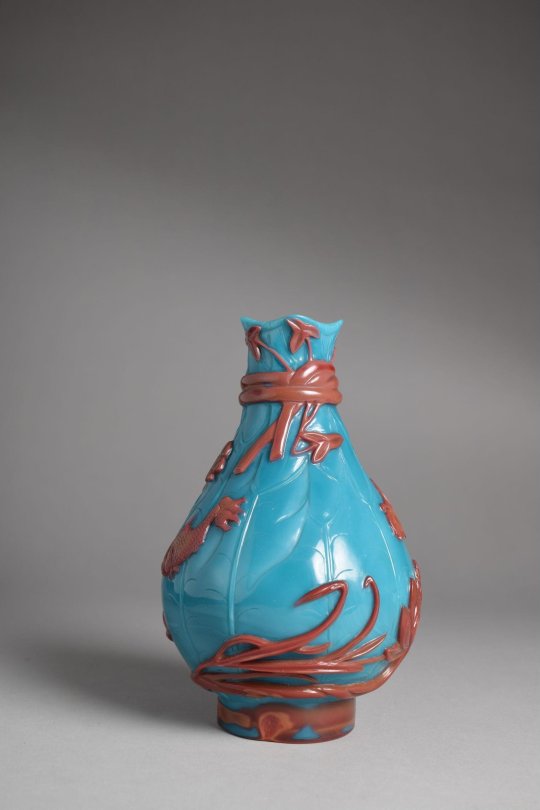
vase in layer-cut glass depicting lotus flowers and shellfish, 1736-1795.
#decorative arts#china#qing dynasty#qianlong period#image source: the victoria and albert museum#museum trawling
22 notes
·
View notes
Photo

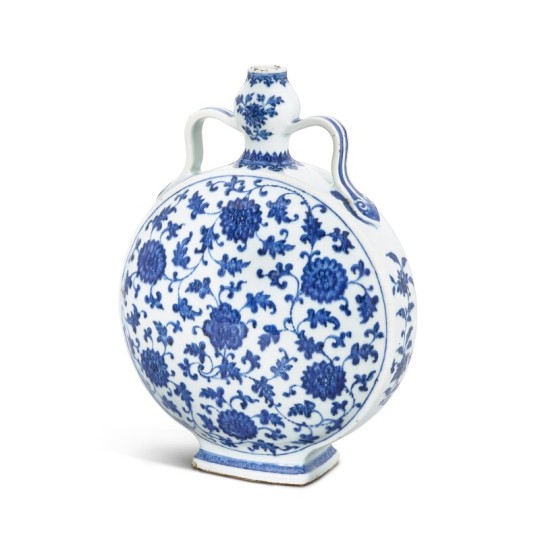

A blue and white 'floral' moonflask
Qing dynasty, Qianlong period
H. 30.3 cm.
#A blue and white 'floral' moonflask#Qing dynasty Qianlong period#pottery#ancient pottery#ancient artifacts#history#history news#ancient history#ancient culture#ancient civilizations#ancient china#chinese history
20 notes
·
View notes
Text
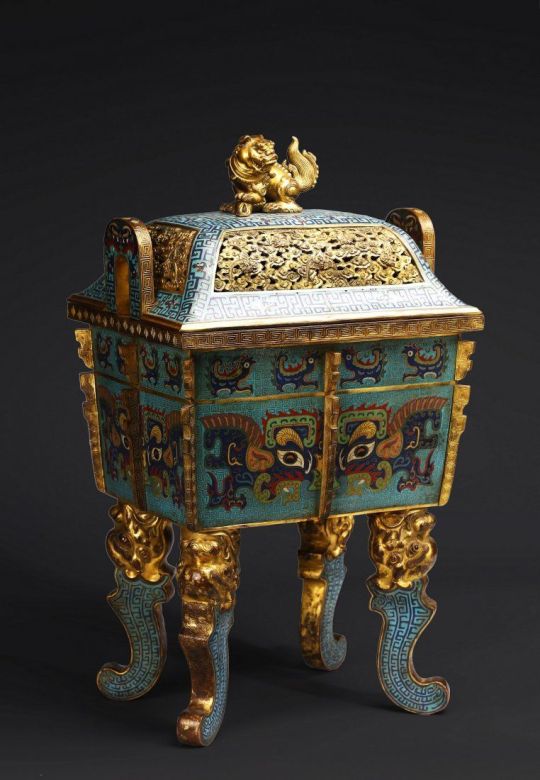
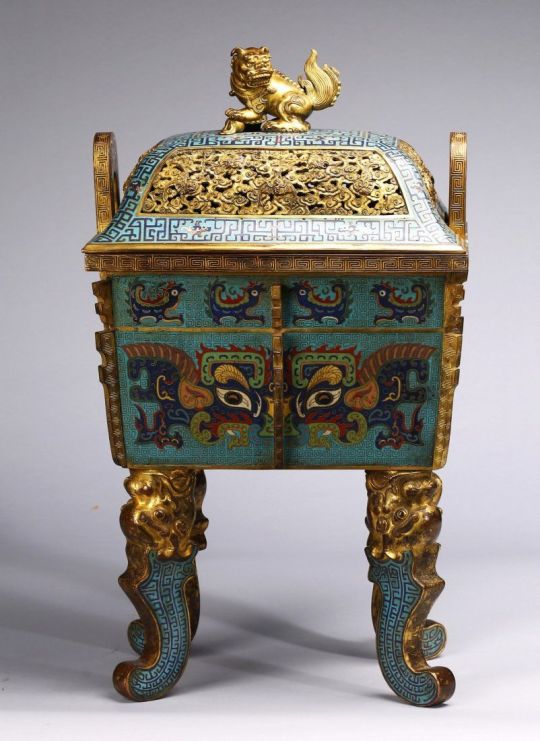




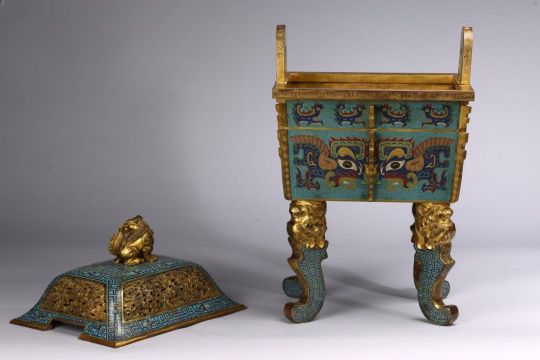
A LARGE GILT BRONZE AND CLOISONNE ENAMEL CENSER AND COVER
The tapering rectangular censer has twin upright handles and is decorated to each side with raised flanges separating a taotie mask below a band of archaistic kui dragons, all supported on four blade-shaped legs emerging from mythical-beast terminals. The reticulated gilt-metal cover is decorated with pierced foliage and enamelled with angular scrolls and is surmounted by a finial in the shape of a Buddhist lion. Qing Dynasty Qianlong period.
Height: 22 3/4 in (57.8 cm) Width: 13 1/8 in (33.3 cm)
8 notes
·
View notes
Text
打鐵花 (da2tie3hua1; struck iron fireworks) is a traditional folk firework that began in Henan and Shanxi, first arising in Queshan county, Henan and later circulating through the whole country. It had first appeared during the Northern Song dynasty, and was most popular during the Ming and Qing dynasties.
For Queshan struck iron fireworks, a two-layer pergola is built and covered with willow branches for performances, under which the molten iron is struck up with two willow sticks to create a rain of fire.
[eng by me + edited an ad out]
(On top of the information in the video, I have some more about its recent history under the cut.)
*Also, a note about one of the subtitles: I realized later that "going into battle without a shield" actually just meant going shirtless. I was only confused about this phrasing while translating because she didn't go shirtless, although that is for obvious reasons
Queshan struck iron fireworks had almost been lost before Yang Jianjun unearthed it again in 1988. It had almost died out in the early years of the Republic of China being established, after which there had only been three performances until 1988: 1952, 1956, 1962. Yang Jianjun had seen the 1956 performance as a 7-8 year old and later on as the director of a cultural centre, began digging up the skill and its history. In the process, he became an apprentice to Li Wanfa, who had been the last head of the Queshan Struck Iron Fireworks Society. He practised with sand and water, learning of its historical origin, its ancestral inheritors, craftsmanship and performance arts, but didn't touch the real thing until 1988. Through Yang Jianjun's efforts and investment, the first struck iron fireworks performance in more than 25 years took place in Nanshan Square (then a deserted area) in Queshan county.
Queshan struck iron fireworks are different from other struck iron fireworks in that it requires a wide area to perform, whereas others only needed a wall or could be hit straight up into the air, and it costs much more money to set up.
The names of inheritors are difficult to trace, and can only be traced back to the Qing dynasty during the Qianlong period, making Yang Jianjun a sixth-generation inheritor, and Jiang Xunqian (OP) the first woman and a seventh-generation inheritor.
#douyin#arts#imparting culture#struck iron fireworks#creator: 江寻千(九月)#personal fav#i spent wayyyy too much time on this#def the most time i've ever spent on a post#i'm v v excited to post this#also i originally tl'd 打铁花 as blacksmith's fireworks and then i realised that wouldn't work
8K notes
·
View notes
Link
#chinese antiques#chinese antique porcelain#fine classic antiques#antique shop online#qing dynasty#qianlong period
0 notes
Text
Amazing fanart by Joanacchi! Posted here on tumblr with their blessing. Each one is based on a style that reflects a particular ancient culture's art history. (See below for descriptions provided by the artist!)
Store (buy these prints!) Twitter Instagram

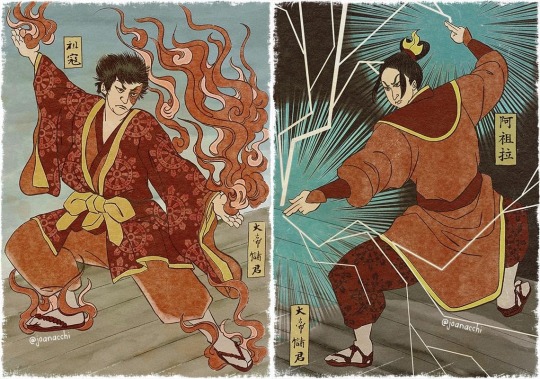
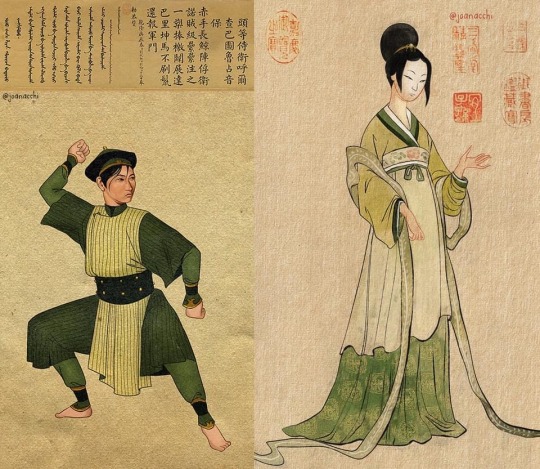
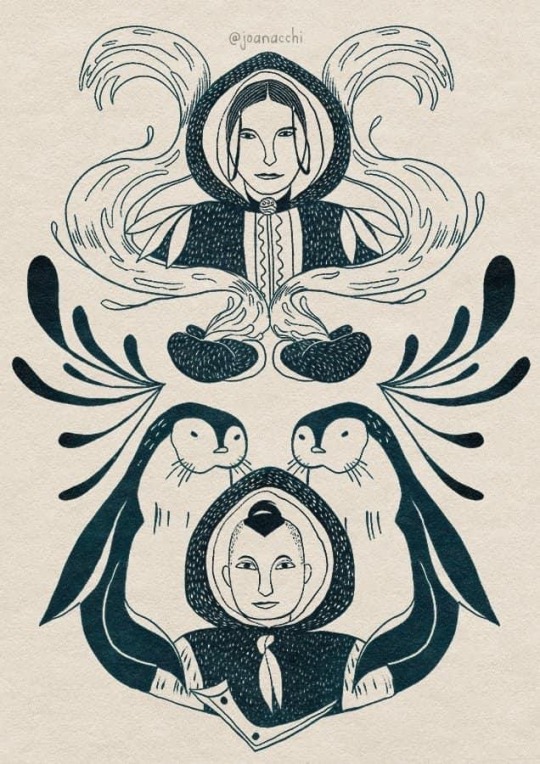
Aang: Tibetan Thangka
"Thangkas are traditional Tibetan tapestries that have been used for religious and educational purposes since ancient times! The techniques applied can vary greatly, but they usually use silk or cotton fabrics to paint or embroider on. What you can depict in a Thangka is really versatile, and I wanted to represent things that make up Aang as a character."
Zuko and Azula: Japanese Ukiyo-e
"Ukiyo-e is a style that has been around Japan between the 17th and 19th century, and focused mainly in representing daily life, theater(kabuki), natural landscapes, and sometimes historical characters or legends!
Ukiyo-e was developed to be more of a fast and commercial type of art, so many drawings we see are actually woodblock prints, so the artist could do many copies of the same art!
I based my Zuko and Azula pieces on the work of Utagawa Kuniyoshi (1798-1861) one of the last ukiyo-e masters in Japan! He has a specific piece which featured a fire demon fighting a lord that fought back with lighting, and that really matched Zuko and Azula's main techniques!”
Toph: Chinese Portraiture from Ming and Qing Dynasties
"Ming Dynasty (1368-1644) was one of the longest in China! It was also a period where lots of artistic evolutions were happening, especially when it comes to use of colour! There was not a predilection for portraits during this time, but there are a lot of pieces depicting idealized women and goddesses from the standards of the time. For this portrait of Toph, I imagined something that maybe their parents commissioned, depicting a soft and delicate Toph which we know is not what she is about ♥️
Qing Dynasty (1644-1912) was the last Chinese Dynasty to reign before the Revolution. One of the most famous emperors of this period was Qianlong, and he really liked Western art! He commissioned a lot of portraits of his subordinates, and I chose a portrait of one of his bodyguards as a reference for the second Toph portrait, which I believe is much more like how she would want to be represented! The poem on top talks about the bodyguards' achievements during a specific war. I had no time to come up with a poem for Toph, so I just used the same one for the composition!”
Sokka and Katara: Inuit Lithograph
"For a long time, Inuit art expressed itself in utilitarian ways. The Nomadic lifestyle of early Inuit tribes played a huge part in that: most art pieces are carved in useful tools, clothing, or children's toys, small and easy to be transported, and depicted scenes and patterns representing their daily lives!
That changed a lot during the colonization. Since the settling of the Inuit tribes, many art pieces began to be created in order to be exported to foreigns, so they started to sculpt bigger and more decorative pieces.
Lithography, which is a type of printmaking, was introduced to Inuit people by James Houston, that learned the technique from the japanese. The art form was quickly embraced by the inuit, as part of the process is very similar to carving. Prints that are produced by inuit artists are still being sold today!
As lithography is not an old art style and it's still commercially relevant to the Inuit communities, since creating these in 2021 I have been donating regularly to the Inuit Art Foundation, not only all the money I get from selling some prints of these but a bit more, at least once a year. Hopefully, I can increase donations this year!”
663 notes
·
View notes
Text
Book review: Chinese Wallpaper in Britain and Ireland (2017) by Emile de Bruijn

*I wrote this last year but completely forgot to post it. Enjoy the old stock :)
I’ve seen a lot of interesting images from this book on Pinterest so I decided to get the real thing, and I have to say I am extremely satisfied with it. This book is about Chinese made wallpapers from the Qing Dynasty (mostly 18th and early 19th centuries) that were exported to Europe and used as decoration in British and Irish homes. Although wallpapers are an interesting subject on their own, I will only be reviewing it only on the basis of how useful it is for fashion history research. This will be a short one.
Great images
Apparently I was not the only person who got this book for the pictures as the review at the back of the book suggests, and I fully understand why. This book contains high quality photos of Chinese wallpapers from the 18th and 19th centuries, in perfect resolution and colors. Even if you’re not interested in Chinese fashion, I would still recommend you to get this book because it also shows beautiful antique British and Irish interiors and chinoiserie wallpapers, and is just plain pleasant to look at.
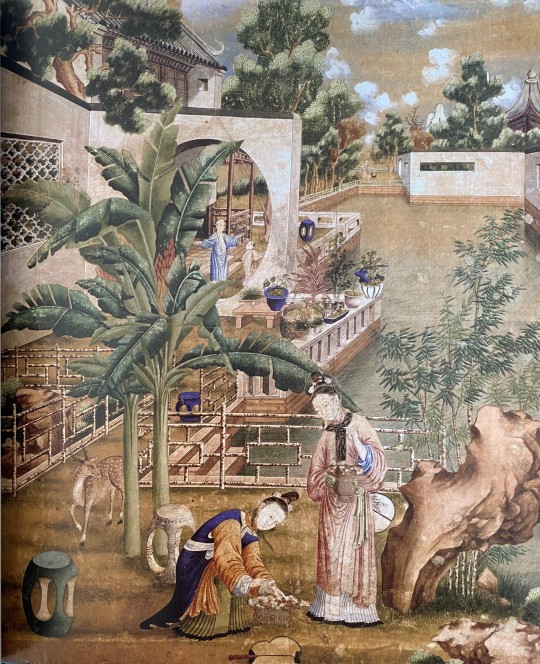
One of my favorites from the entire book, a full page spread with delicious details of a wallpaper depicting a Chinese garden using linear perspective. Even better that the ladies are clad in Qianlong era garments.
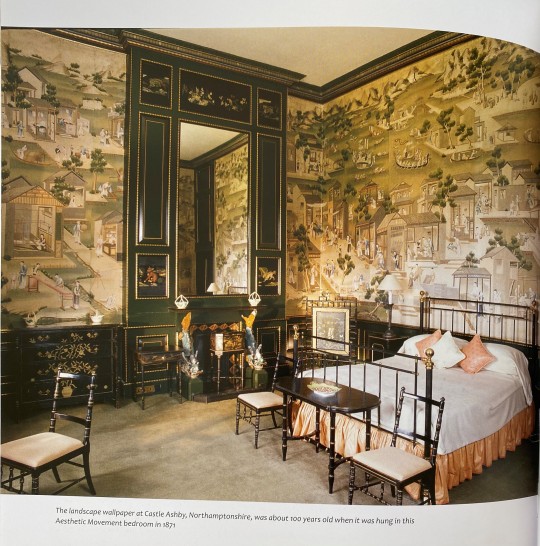
Photos of interiors are also immaculate.
The importance of commercial art
Commercial art like wallpapers, portraits and export paintings is very marginalized in the study of Chinese art, so I highly appreciate that this book sheds more light on a category that traditionally finds absolutely no favor with Chinese art historians. Because of commercialization and increased trade with Europe, popular artworks from this era that depicted life realistically often employed Western painting techniques at least to some extent, meaning they don’t look very Chinese and are often neglected by scholars; more stereotypically Chinese literati painting genres, such as landscape painting or 仕女画 shinvhua (idealized paintings of women) are definitely way more popular among art historians.
Literati painting seldom, if ever, depicted people’s clothing realistically. Costumes were meant to be excessively flowy, adhering to people’s imagination of deities and supernatural beings. Sometimes hints of contemporary fashion could be seen if you know what to look for, because the artist’s imagination had limits and they couldn’t just pull an outfit out of thin air. But still, literati paintings should never be used as resources for the study of fashion history, because the clothing shown had little to no connection to what was popular in real life. Commercial art, on the other hand, depicted real people with real fashion, but is seldom shown in museums or books on Chinese art history because it was considered vulgar and inferior by the literati upper class. In my opinion, commercial art is miles more interesting than literati painting, because literati art has changed relatively little over the course of Chinese history due to conservative Confucian morals, whereas commercial art was usually more reflective of their time and popular tastes. The only non literati Qing painter to ever receive mainstream attention was probably Castiglione, but he was also a court painter and didn’t belong in the commercial category. Even Lam Qua is niche. The commercial export paintings made by native middle class artists of the Guangzhou thirteen factories (十三行), who had more freedom and pioneered new art forms (like reverse glass painting), are rarely discussed.

Literati painting attributed to 焦秉贞 Jiao Bingzhen (active 1689-1726). The costumes of the women, which are extremely stylized and historicist, follow rules of the genre established centuries ago and do not reflect actual fashion. Jiao could paint in the Western style as well, I’m just picking a shinv piece he did. This is the type of stereotypically Chinese art historians love to focus on.

From Chinese Wallpaper, likely made in the late Qianlong era (1770s-1790s). This kind of more down to earth art illustrating everyday life is a lot more rare to see, especially those where the artist attempts Western shading or perspective.
Because “Chinese art” for most people only encompasses literati painting, calligraphy, ceramics and other such stereotypical disciplines, seeing the relative lack of them in the Qing it’s easy to jump to the conclusion that art was not produced with the same rigor as in previous dynasties, which then leads to notions about the Qing being conservative and uncultured and such. No, art was abundant in the Qing, it’s just that the popular taste in art has changed so it was often made in a different medium (oil painting, print and indeed wallpapers) using a combination of Chinese and Western techniques. Scholarship on mediums like oil painting (China trade painting) and reverse glass painting has been virtually nonexistent until very recently; the first thorough monograph of reverse glass painting I’ve read is Thierry Audric’s 2020 Chinese Reverse Glass Painting 1720-1820. I really hope that as research on Qing export art accumulates, it would be able to finally integrate itself into the wider timeline of Chinese art history. So on this matter, thank you de Bruijn for making a whole book on a niche category of Chinese art.
Underrated era
Now with the context out of the way, I can talk about fashion. Although there is no mention of fashion in the text since that isn’t what this book is about, the images included are great for illustrating fashion in the early to mid Qing, which is not well represented in the study of Chinese fashion history at all. I’ve talked multiple times about 18th century erasure on this blog, and I think this book is a very good antidote to that. The bulk of the wallpapers featuring humans were from the Qianlong era (1735-96), a personal favorite era of mine, and there are also several that depict the Jiaqing era (1796-1820), which is even rarer.
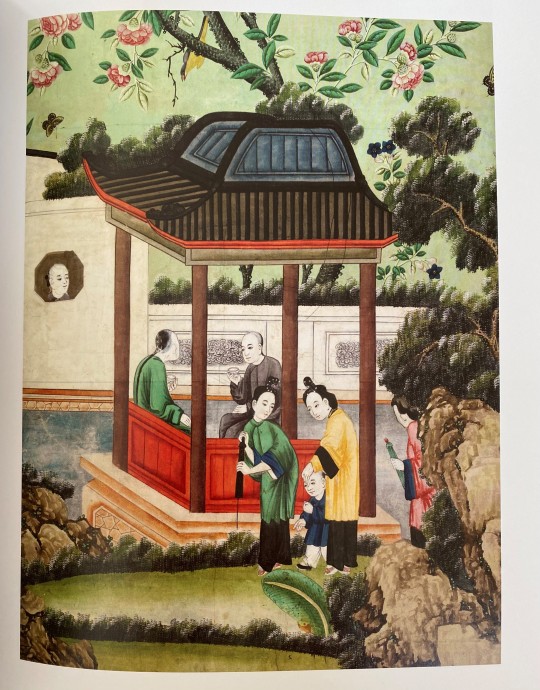
What seems to be Jiaqing era clothing. The unicolor robes with black binding paired with plain black pants or skirts have a very casual and pastoral look. The style is weirdly reminiscent of modern stereotypical “Republican era uniform” Halloween costumes, but way better.
Conclusion/rating
This is a short review because the main point is that this book has plenty of nice images of an underrated era. Without a doubt 9/10. One point off because it would be nicer if the wallpapers are dated, but that’s a minor qualm.
262 notes
·
View notes
Photo

A large white jade 'prunus and lingzhi' vase and cover, Qing dynasty, Qianlong period (1736–1795).
552 notes
·
View notes
Text

A rare gilt-bronze and cloisonné enamel container in the shape of a duck ,
China, Qing dynasty, Qianlong period (1736-1795)
Artcurial
812 notes
·
View notes
Photo

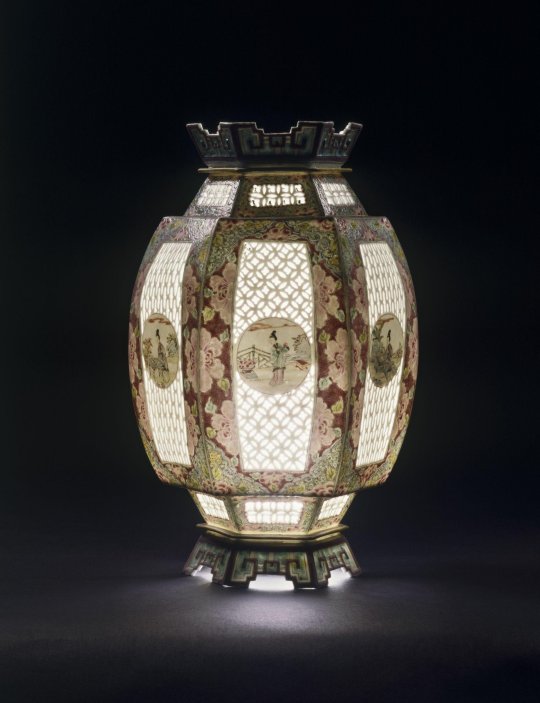
six-sided porcelain lantern with different pierced openwork patterns, enameled peonies, and medallions of court ladies, 1725-1750. such openwork patterns were cut with a knife while the clay was partially dry.
#decorative arts#china#qing dynasty#qianlong period#(probably)#museum trawling#image source: the victoria and albert museum#i looked at this and went ehhhh a little too flowery for my taste. and then i saw what it looks like lit!!!!
24 notes
·
View notes
Photo



A large spinach-green jade archaistic beaker vase
Qing dynasty, Qianlong period
Height 34.8 cm, 13¾ in.
#A large spinach-green jade archaistic beaker vase#Qing dynasty Qianlong period#jade#jade vase#ancient artifacts#history#history news#ancient history#ancient culture#ancient civilizations#china#ancient china#chinese culture
22 notes
·
View notes